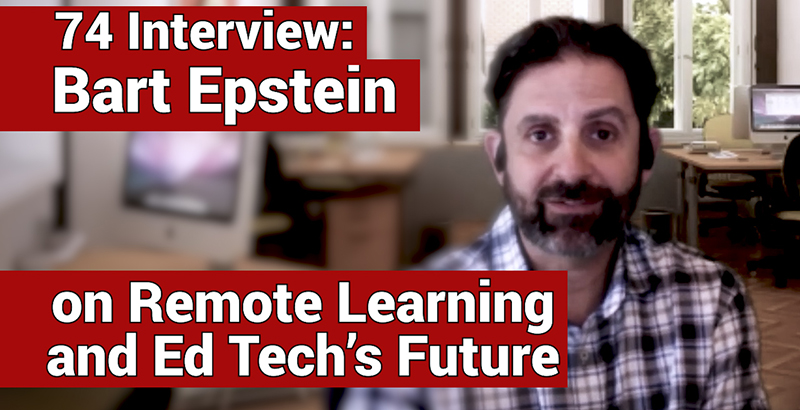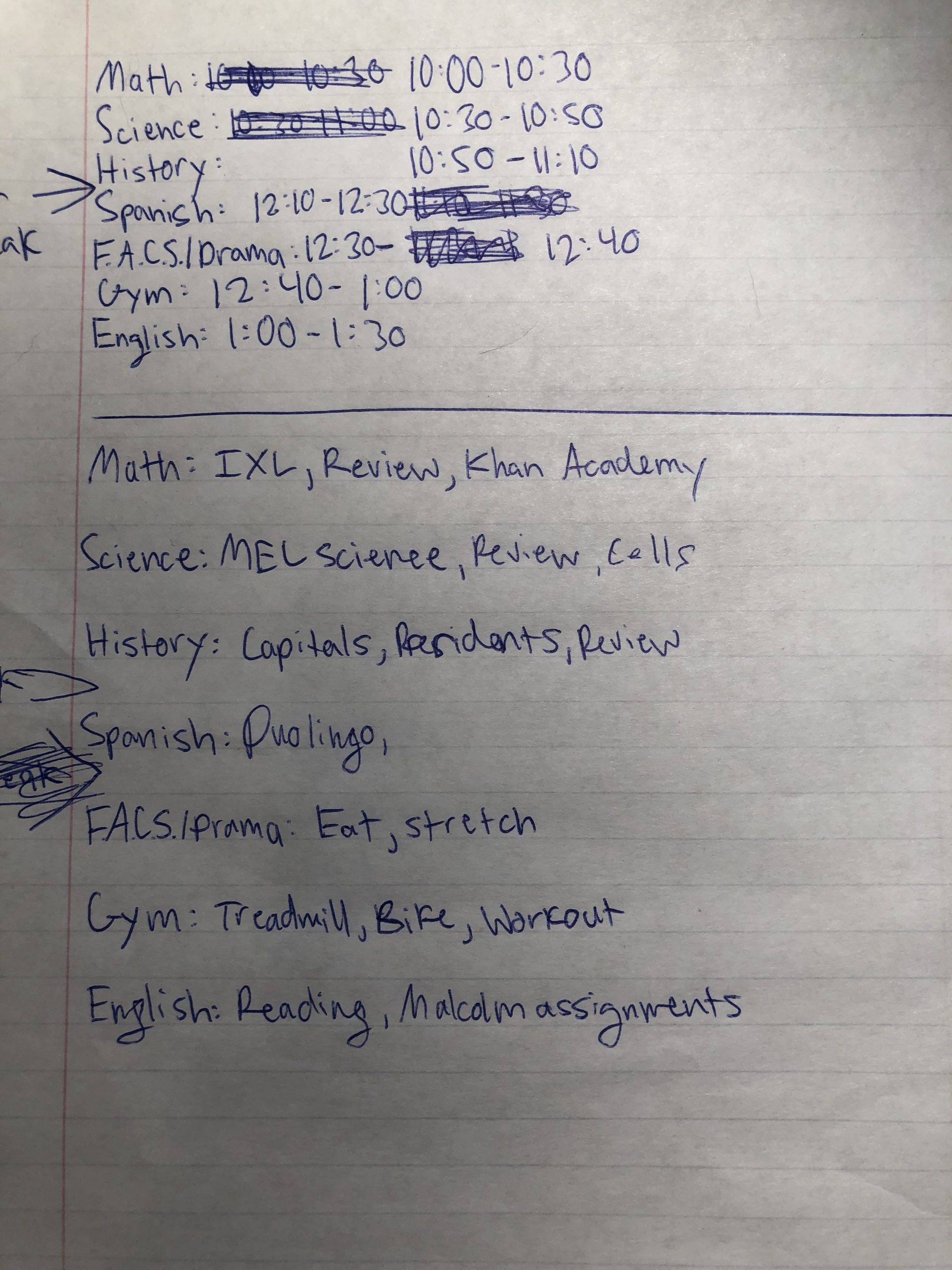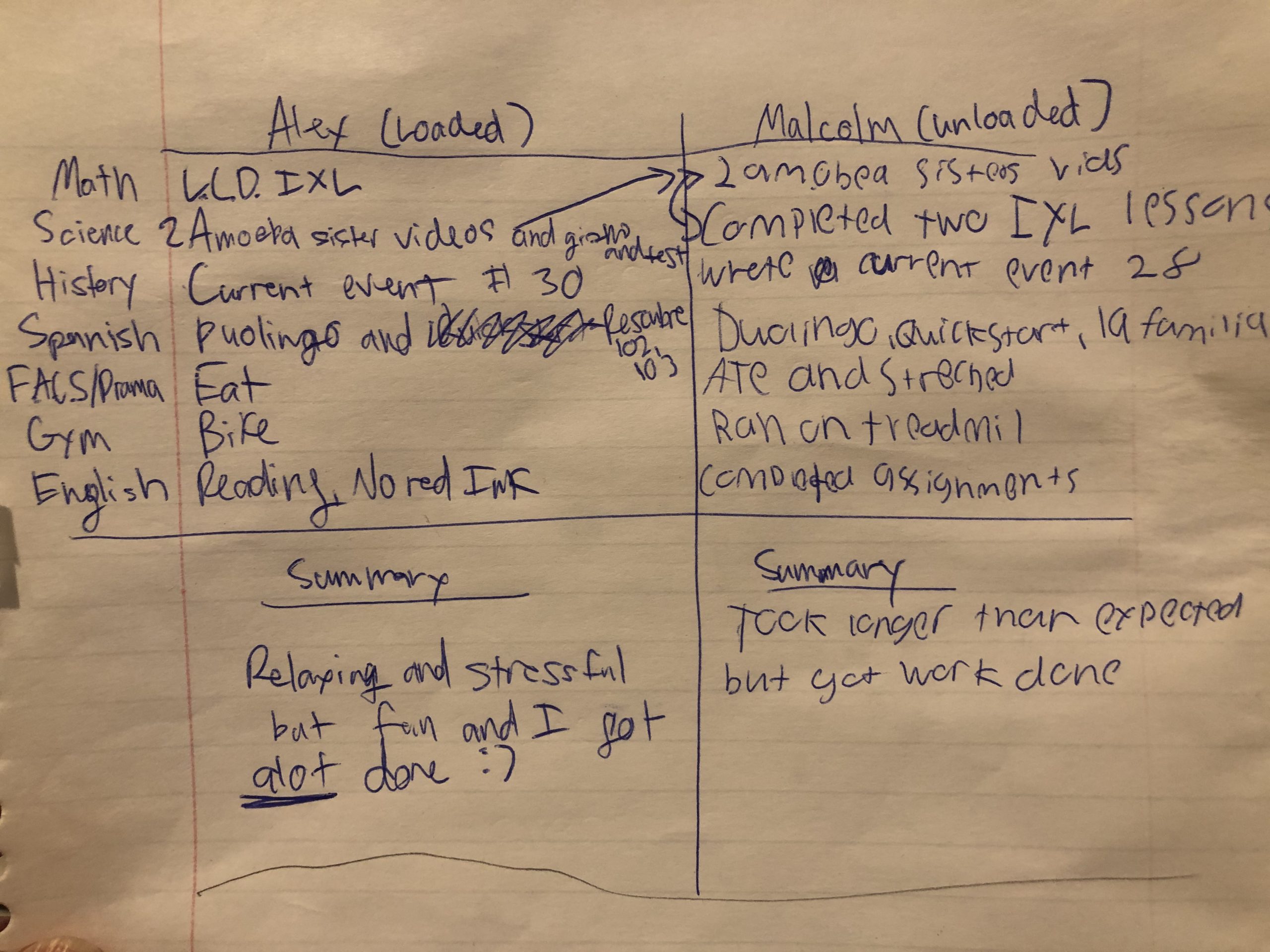74 Interview: In a Galaxy of Ed Tech, How to Figure Out What Distance Learning Materials Really Work, and Expert Bart Epstein’s Unconventional Home Learning Strategies

Bart Epstein has seen the education space through a previous role in which he helped build Tutor.com, the world’s largest online tutoring and homework help service. He’s also a parent trying to navigate homebound instruction for his two sons.
Now president and CEO of the Jefferson Education Exchange, a nonprofit dedicated to helping educators and educational leaders make better decisions about educational technology, Epstein is doing his work and being a parent through a lens that also includes experiences as an SAT teacher and tutor, the founder and CEO of the nation’s first efficacy research-focused ed tech accelerator and venture fund, and serving on the board of ASCD, a nonprofit focused on teacher advocacy and professional development. He is also a research associate professor at the University of Virginia Curry School of Education.
As summer approaches and as families adapt to learning during the coronavirus pandemic, we talked with Epstein about ed tech products, the role of schools, what he’s doing for his kids and ideas parents can use this summer. Epstein also discussed the ed tech sector more generally, what’s needed to improve overall quality and what the impact of coronavirus might be. A few of the highlights:
Here’s Epstein in his own words. The interview has been lightly edited for clarity.
What do you recommend for parents if their school is not giving new assignments out right now because of this crisis and the shutdown?
There’s so much good stuff out there but almost all of it is à la carte, meaning that the materials and resources that are good for math are completely different than those that are good for reading and science and civics. So I recommend that parents start by looking to their kids’ schools and teachers for recommendations, assignments and information about ed tech products that the school has already paid for. So if your student already has a login and is familiar with a certain program, they are more likely to use that program and to use it properly than they are if you find something brand new.
Other benefits of using school-associated program accounts are that your kids’ teachers can usually track your kids progress inside the program and your teachers may be able to better provide help on specific homework problems. But there may be a big difference between the official resources that schools put out and what individual teachers recommend, so don’t be shy about asking teachers, informally, what they recommend.
How can a parent tell what’s high quality or not?
This is a big problem and unfortunately, unless someone invents time travel and we go back and invest a huge amount of money into doing efficacy research, we’re not going to have much information about what works or where or why. Our education system is extremely fragmented and as a result, we have 14,000 or so school districts each making independent decisions about what to buy. They largely do this without the benefit of efficacy research.
There are some products that have reviews in the federal What Works Clearinghouse, but not much and there are no good, reliable, independent resources for evaluating the efficacy of most programs. Now, there are indicia of quality that you can look to. Sometimes you have to chase it down to different places. For example, ISTE, The International Society for Technology and Education, is a nonprofit that helps educators use technology in schools. They have something called the ISTE Standards and they’re going through a process of trying to identify and certify and issue badges to the companies that comply with the ISTE Standards.
There is a non-profit called edreports.org that has done detailed reviews of around 70 of 80 instructional material suites. But those things tend to be more school-based programs as opposed to individual things that parents and kids can use but I strongly recommend looking to edreports and Common Sense Media and EdSurge and ISTE to see if there’s any information available about a product that you’re considering. I’d also say that the people who know best are the teachers and if your kid’s teacher talks to his or her peers or their professional association and they can report back, informally, that they’ve heard good things and what types of students it may be valuable for, that may be the best that you can do.
Parents are having to spend a lot of time managing their children’s learning through this crisis. If you’re having an online-enabled experience, what could an ideal day look like?
It highly depends on the age. No first-graders are going to be self-directed and spend an entire day engaged in learning activities by themselves. But as students get older, it becomes more important, effective and powerful to give them as much agency as possible. I can’t overstate how valuable it is to make your kids as responsible as possible for their own learning. If you give them a strict list of things to do, they are often marching through them as if they’re doing chores. But if, instead, you spend some time trying to identify, “What’s the concept that they need to learn? And why does it matter? And where could they get the information? And how will they know if they’ve got it?” Then they can be more responsible for going through and looking at competing products and resources to see which ones they like.
So, with my kids, when we have a question that comes up, I ask them, “What do you think? Which one’s better? What should we use? How do you know? What do the reviews say? What are the pros and cons?” I don’t have time to deal with all this and it works out conveniently very well for me to empower them as I believe a previous administration used to say, “Tight on outcomes, loose on means.” Let them figure out their own path.

When I was teaching high school SAT prep classes, I had these classes of students show up and they had no interest in being there and I wasn’t their teacher, I was not giving them a grade, I didn’t have the power of the state. They were busy, it was a Saturday, but I knew how important it was for them to do well on the SAT and to improve. So I went with an approach of radical honesty where I explained to them that it’s up to them and here’s the reason they should focus and spend an extra 100 hours studying with me over the next month and instead of jumping right into lessons. I motivated them by talking about college, “This is what it’s like to be on your own and to be able to choose what you eat every day, and guess what? When I first got to college I learned the hard way that you really shouldn’t eat just Twix and Arby’s. I enjoyed learning that lesson at first.”
Kids today don’t get enough exposure to controlling their own destiny. They are marched from class to class, they are told what to study, in what order and how and I view this crisis as an interesting opportunity to let kids have a different experience. My boys tell me that they learn more at home on their own in four hours a day than they learned, most days, sitting in classrooms with other kids for seven-plus hours a day. And that’s largely because they pick what they do, in what order. They certainly have requirements, they need to do a certain amount of math, they need to have quiet reading for an hour but what they read during their quiet reading hour is up to them as long as it’s rigorous. I don’t care what it is. They’ll still do their school reading but I want them to have a love of learning. And so everything that I do is as much as possible focused on them being responsible for their own path.

Our kids being home from school now is a golden opportunity to let them discover what things in the world they find interesting and to set their own schedules. My kids know they can’t have any screen time until they’ve finished their school work and their chores. But I tell them it’s entirely up to them how they make their schedule for the day. And I have to tell you, it brings a tear of joy to my eye when one of my boys says to the other one, “We’ll be happier if we just get our school work all done by lunch, then we can have fun the rest of the day.” Because as the morning rolls on, it’s not me checking in on them and scolding them, it’s them holding themselves and each other responsible.
Kids are spending a lot of time in front of screens, but in your own family, what are some non-screentime things that your kids are getting into and some enrichment that you’re doing?
My kids spend less than half of their learning time on screens. My other son recently picked some hilarious science books to read. One of them was called What If? Serious Scientific Answers to Absurd Hypothetical Questions. And it’s written by a popular web comic creator who takes absurd questions and then answers them with cold-hard science and diagrams. Answering questions like, “What would happen if everyone on Earth was in the same place and they all jumped simultaneously?” Or, “What would happen if you went swimming in the containment pool of a nuclear reactor?” And in each case, the answer involves physics or math and it gets him thinking or wondering, and that’s the real goal.
Other things that we do are, we separate our day into official school work and then creative time and then play time. And during creative time, no matter how old your kids are, they want to be creative, they want to do fun things, they want to build things, they want to experiment, they want to break things. My boys built an elaborate train set from their childhood — Thomas the Train — with tracks running through the kitchen and over the table and then over a chair and down around a spiral and then they would deliver snacks to each other.

I empowered them to cook whatever they wanted and they’re 13 now, I figure we have fire alarms, smoke alarms, worst case scenario, I can get out of the house in time. But I was on a Zoom meeting and there was a knock on the door and one of my sons said, “Daddy, where are the little flame throwers?” And I thought for a moment, and I told him where they were and I couldn’t believe it, they made crème brûlée from scratch. And they bake and when they bake we use that as an opportunity to do math and to extrapolate on how to make recipes on larger numbers of servings. We also painted a wall with whiteboard paint and we do lots of math on there and we also talk a lot about the current events.

This is the kind of thing that is especially relevant now and it’s a great opportunity to let your kids talk to you instead of you talking at them. Have them go online, read and give them potentially two conflicting opinions and then have them synthesize and come back to you and make an argument.
One of my favorite tactics is to have my student or my kids research something and make an argument for why we should do it. Such as high school start times should be delayed until 9 a.m. And then they come and they make their argument and then I say, “Great job. Tomorrow, make the opposite argument.” And developing that kind of thinking flexibility and empathy for other people’s positions is a kind of learning that’s often hard to get done in school and it doesn’t need to involve screens at all.
This is another one of my favorite teacher tricks. It’s self-serving but it works. If one of my boys doesn’t understand how to isolate a variable in the denominator of a negative fraction, the answer isn’t, “Interrupt daddy who is doing a Zoom meeting.” It’s, “Go ask your brother and have him teach it to you and if he can’t teach it to you, you guys go together and talk to one of your other friends.”
Between their peer group, everybody knows something and it makes everyone feel good to have a chance to be the expert. And having two kids in the same grade, of course, gives me an advantage but even if you are in complete isolation, your kids can use House Party or FaceTime or another video chat service to connect to their friends.
And to the extent that they are looking at screens, I highly recommend that parents, if they can afford one, get their kids a Kindle. The cheapest Kindle is now $89 at most and in our house, nothing has sparked more of a love of learning and reading than my kids owning a Kindle. Even if you can’t afford many or any books, there are tons of classics that you can download for free. It has a built-in vocabulary tool that keeps track of the words that you look up. It is a wonderful resource.
I recommend that you get a student subscription to newspapers. Things like The New York Times, The Wall Street Journal, The Washington Post, and then let them pick an article or two each day to read and summarize or criticize. Also, I strongly recommend audio books. Somewhere along the line, my kids fell in love with audio books and they have now listened to hundreds of hours of stories that I have never heard of. Some of the things they listen to seem crazy to me, but who cares? It’s not for me and it brings me great joy to hear them excitedly telling each other and their friends about the characters and what happens to them.
What’s the impact of coronavirus shutdowns going to be on the ed tech industry?
It’s going to be tremendous. The impact on the industry is likely to be so profound that it’s hard to put into words. Millions and millions of kids right now are falling behind and will never recover. That is the unfortunate reality of this situation. They were already in schools where they were struggling and falling behind. Now, many of them are going to go without any learning for six months and will have forgotten much of the math and the science that they had learned the previous year and schools will be under understandable pressure to stay on track. And my kids’ school announced that anyone who was in academic standing as of early March is being promoted to the next grade.
Well, that’s a mixed bag. That may be doing a disservice to students who have not learned the material in the grade that they have yet to finish properly and if you think of it from the perspective of a customer, they, through their taxes and their time, have paid for a year of schooling and they didn’t get it and in the fall, schools are going to need to either delay all of the fall instruction while they teach what they missed in the spring or they’re going to have to try to operate at more than 100 percent efficiency. Meaning, trying to teach 120 percent worth of material every day and every week so that they can catch up and then get back on track.
That is impossible without education technology that is properly selected, implemented, supported and used. Ed tech that can meet those criteria are likely to become indispensable and heavily used in schools throughout the country. Meanwhile, technology that is barely used and had previously been more for show than for actual use is at great risk.
How can parents and teachers encourage at-home learning or distance learning if resources are scarce?
There is so much free stuff out there that’s good. The only question is how to find it. Every topic area has good stuff and it just varies based on the age and the subject. I recommend, in each case, starting with your school teacher. If the teacher doesn’t know, then potentially ask the school’s assistant principal or principal if you can be connected to the department head. You can also look to your local schools of education. You can look to your PTA and ask around for who has done this work.
Another thing to keep in mind is, it’s very unlikely that you are the first parent to have this question and if each parent picks one little topic to dive in on, then you can all exchange information with each other. So if chemistry is something that your daughter really cares about, you and your daughter could spend a few hours investigating all of the online chemistry resources that you could find and read reviews and try things out and watch videos and do a write up for your peer group that says, “Here’s what I found. Here’s what’s authoritative.” And hopefully someone else in your social circle or in your school community would do the same thing for another topic.
Now more than ever there is an urgency to ensure that distance learning materials that students consume are effective. So who needs to do what and when?
A problem in our education system is its fragmentation. By and large, as a country, we are doing a very poor job at selecting and using education technology. The data that we have been collecting and analyzing suggest that more than 85 percent of the dollars spent on education technology goes to licenses that are barely used or never used and this is mostly because people don’t understand what is likely to work in their local context and how to implement and support it.
So what we need are two things. The first is we need somebody to do real efficacy research on the products that get used the most. This likely requires federal support through the Department of Education’s Institute of Education Sciences and the Office of Educational Technologies.
The other thing we need to do is we need to learn from each other. This is the work of the Jefferson Education Exchange and the University of Virginia Curry School of Education that are focused on collecting large amounts of data from huge numbers of educators, nationwide, who report specifically on which ed tech tools are in use in their classrooms. How did they get there? How are they performing? What’s the training like? Interoperability, support, competing initiatives and everything else that we need to know so we can make better decisions about which technologies are likely to work for our own schools.
What’s the most common thing that people get wrong about ed tech?
Most people think that ed tech is like other consumer technology. That it is well designed to be user friendly and is very easy to use on your own. And that’s just not the case. When Apple makes an iPhone, the user interface is used by billions of people, it merits an unbelievable amount of thought and care. But ed tech companies are by and large, fairly small. Most of them are started by former teachers who saw a problem and they want to fix it and it’s hard to get funding, it’s hard to sell into schools. And a lot of times, things that have great pedagogy and work well are not designed to be beautiful and seamless and intuitive in the kinds of ways that we all would wish.
In schools, the biggest mistake we make with ed tech is being too aspirational and unrealistic about what it takes to do right. Most things that go wrong with technology in schools happen when someone makes a well intentioned decision to buy a product because they really think it’ll help their kids but they don’t realize that they don’t have the necessary prerequisites in place in order to implement it properly. It’s not enough to just buy technology. The only measure that really matters is how much learning is happening and you can’t have learning without usage.
So if a school buys an ed tech product and it’s only used by 15 percent of students, by definition, it can’t be helping those 85 percent of students. We need much more transparency there to be aware of when products are not being used.
Help fund stories like this. Donate now!

;)

